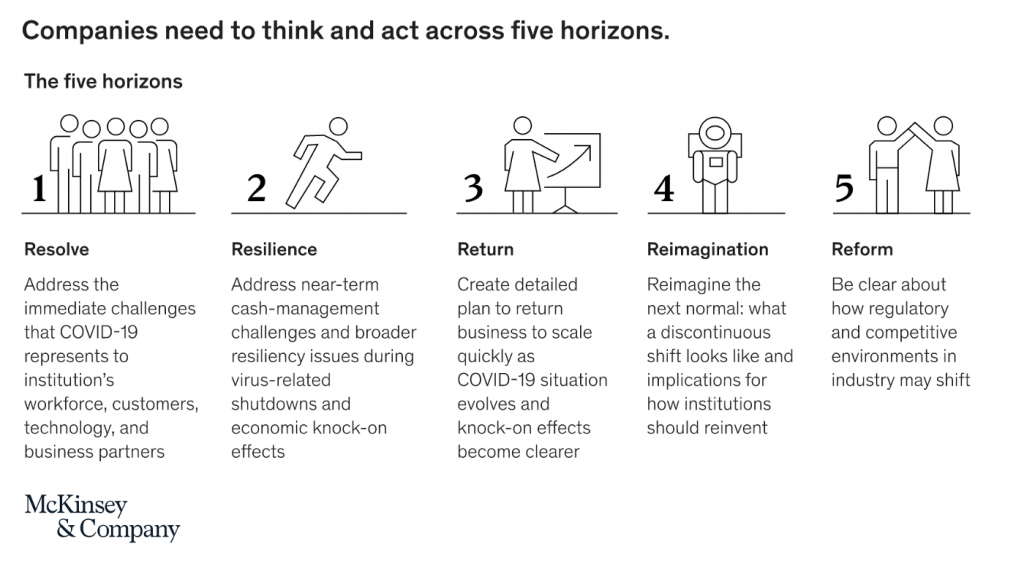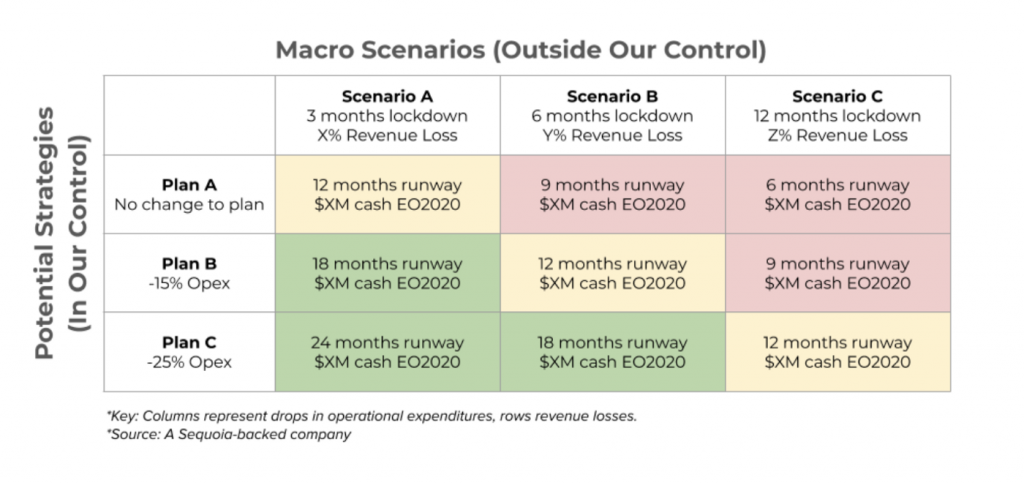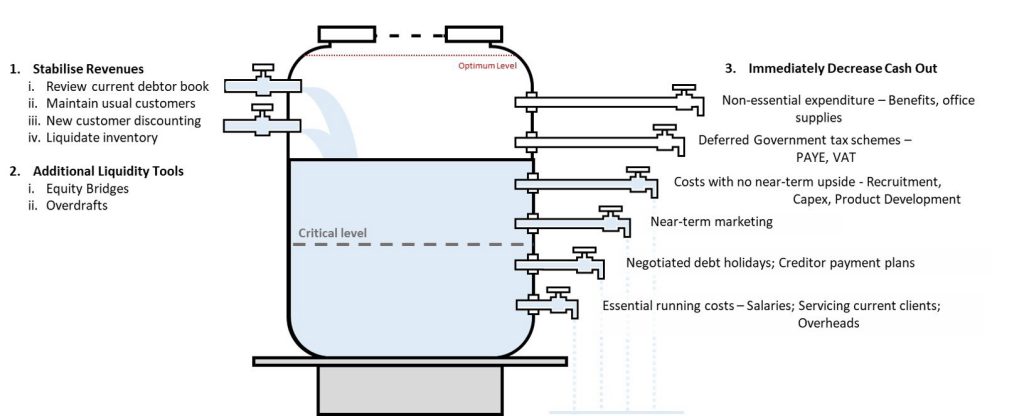I was seven when the dot com bubble burst in 2000. My only exposure to technology was our family’s Macintosh from the 90s.
When Lehman Brothers filed for Chapter 11 in 2008, I was 15. Looking back, I recall CNN broadcasting of both NYC and London’s financial districts with employees kicked out on the streets but I was still too young to understand why. I certainly didn’t know what mortgage-backed securities were (or even a mortgage).
Now it’s 2020. And I feel this one.
Today I am a 26-year-old co-founder/COO of Bunch.ai, a startup based out of New York and Berlin. Unlike 2000 and 2008 which were primarily financial in nature, 2020 has mutated into a public health emergency the likes of which haven’t been seen in over a century. That means there are many leaders out there navigating their teams through a crisis of this kind for the first time, like me.
Right now a majority of our team is in Berlin where the German government currently restricts meetings of more than 2 people. The world is now in uncharted territory with an unparalleled high of 6.6 million people filing for unemployment in one week in the US. President Trump’s 2 trillion dollar stimulus makes Obama’s 830 billion in 2009 look small and in an act of “war with an invisible enemy,” the US has deployed the USNS Comfort and the USNS Mercy on both coasts to manage the hospital overflow.
From what I can observe it seems most leaders have now accepted that this crisis is more than just an economic hiccup and a temporary adjustment to remote-work. Looking back at the past 3 weeks, below is what I have found as a startup founder co-leading through COVID-19.
Take care of your team first
Protect your most important asset first — your team. It’s been three weeks now since the WHO announced that the COVID-19 outbreak is a pandemic. Our founding team quickly adopted the following three principles to guide our response:
1. Keep our employees safe, secure, and healthy
2. Continue to serve our existing users to the best of our ability and standards
3. Support the societal mission to reduce community spread of the virus and flatten the infection curve
As a comprehensive response to all three, we sent our entire team home indefinitely the day after the WHO announcement. We saw this not just as a ‘medical’ move, but as a strategic decision. Without our team feeling safe and secure, we can’t serve our users, and if we can’t serve our users, we flatline. Helping our team and their families take care of their basic needs and adjust to the new normal as quickly as possible meant more people looking out for the survival of the business.
Stay calm in order to remain strategic
Leading in crisis requires individual resilience. This is achieved in-the-moment by remaining strategic as your business, customers, and team are being tested. You need to keep your head up and eyes open to see where the emerging threats and the greatest risks will come from. If you need something to lean on try the founder-friendly Corona Canvas.
Bullet Wound vs. Plane Crash
With a bullet wound, your immediate response should be to stop the bleeding or you won’t live to see another day. Unless you have had a key strategic partner pull away right out of the gate and need to prevent others from doing so, your response should look more like the important piece of safety advice you receive before every flight — in case of an unexpected crash put your oxygen mask on yourself first before helping others. As an operator and leader, this means first increasing your readiness to respond to better prepare for hidden threats and opportunities.
Tap into your support
A tree is only as good as its root system, so surround yourself with quality leaders from the get-go whether on your board or as advisors. Tap into your support system and increase the frequency of communication to your team and shareholders. Crisis is when this support pays for itself. We opened up an #ask-coronavirus channel on Slack and we are now sending short weekly management updates to shareholders. We’re the first to admit we went into our initial crisis response board meeting more on the defensive than ultimately necessary but thanks to our support we came out balanced.
Maintain strong defense
It should go without saying that it is your job to plan for worst, be fiscally responsible and even welcome a little paranoia. Crisis makes you question the fundamentals — why are we here? What’s essential, what’s not? Can we do more with less? Don’t ask yourself what you can cut because you could hypothetically cut anything — ask what you will need and cut what is unnecessary.
But don’t stop playing offense
In the beginning, even the best may assume the worst. While it is absolutely necessary to be frugal to make it out alive, your mindset doesn’t need to be only inward. You should remain as customer-centric as possible — look for win-win opportunities to help your partners and supply chain out. If there are market opportunities, get those moving. These are inspiring for the team and prevent flatlines in motivation. After talking to just a few users, our team quickly saw an opportunity to focus our product strategy on our user’s new daily routines— commuting from the bedroom to the living room and leading through Slack and Zoom.
Cluster tough decisions together
Whether it is shutting down offices, letting people go, cutting salaries or letting a part of the business die, you as a leader have built up an intuition about what is critical and now is the time to deploy that. Cluster tough decisions together and communicate them without too much time in between so the business can move on. Don’t release some information to one part of the business and not others. Don’t allow confusion into your ranks.
Don’t forget your community
Don’t shy away from going beyond your products and customers to helping your wider community. Startup leaders usually have versatile teams and networks that can be very valuable in a crisis. With 1 day of effort and no cost to the company, our team raised money for 4–6 weeks of disinfectant & masks for Berliner Tafel — an association here in Berlin that uses leftovers from supermarkets to feed those who otherwise would go hungry.
Operational Resilience
Change creates winners and losers. As a startup leader, you likely understand change is a part of living and growing but unless you are very fortunate, your team was likely knocked down or had to reset recently.
Individual resilience is what gets you back up. Operational resilience keeps your team serving customers and adapting to changes. It’s still early days and many companies remain in a prolonged state of resolve and resilience (see visual below) with lockdowns and social distancing being extended all over the world and the US predicting their peak pandemic is still a few weeks out. Eventually, “businesses will need to act on broader resilience plans as the shock begins to upturn established industry structures, resetting competitive positions forever.”

First, what to avoid
As difficult as it can be amidst the chaos and incoming advice, you want to avoid short-term reactions to the events alone with long-term negative consequences. While short-term liquidity and cash planning are urgent in the initial phase, operational resilience is truly preparing your business to adapt to emerging threats and decoupling continued performance from the unfolding events themselves. If your business is fortunate enough not to rendered redundant immediately, unnecessary damage can be done in the long-term by how you react now. As MIT author and systems thinker, Peter Senge explains in The Fifth Discipline: The Art and Practice of the Learning Organization,
“Herein lies the core learning dilemma that confronts organizations: we learn best from experience but we never directly experience the consequences of many of our most important decisions.”
Actions to avoid now:
- Leaving key vendors/partners that are connected with serving your current clients and maintaining critical product standards.
- Acting on your worst-case scenario blindly and separating with key team members that would be critical to getting you out of the hole.
- Over-monitoring your team on Slack in an attempt to ensure productivity but in-the-end creating insecurity and therefore losing their ability to help you serve existing customers.
- Restricting the autonomy of your key managers and experts to come up with creative solutions to unfolding circumstances.
- Anything else that would harm your ability to serve and delight your core customer segment that if you took away would cause your business to approach flatline.
Step 1: Survivability
Before you do anything else, quickly assess your survivability.
Start with your current cash balance and create a no-revenue, worst-case scenario. Dividing our current cash balance by our current running costs (not burn rate), we were depleted before the end of the year.
Next, run revenue scenarios at 30%, 50%, and 75% fulfillment. What are the drivers of your revenue and how will those drivers be hit by varying lengths of lockdown? Scale them back to see what the impact on revenue is and what the minimum is required to survive. You will get a different runway target from everyone, but we are aiming for a target of 12–18 months. Below is a helpful mental model shared by Sequoia Capital on the future scenarios to consider.

Step 2: Stabilize Revenues
Do everything you can to keep existing customers as it is always cheaper to keep current customers and than to acquire new ones. Invest in your core customer segments and try to anticipate their needs. We are B2C so we are watching the incoming consumer behavior data closely.
If you are B2B you want to consider the impact on your customers’ capital and op-ex as well. How can your company help your customers be more efficient throughout the crisis? If you fail to secure ongoing cash-in or important supply-side partnerships, your business may be only a few unfortunate surprise customer emails away from falling to critical.
What you can do
- Get on the phone with major clients and partners and see what the impact is over there to achieve second-order visibility.
- Make sure you bill everyone you need to. Evaluate default risk and incentivize early payment.
- Invoice and call for all receivables that are waiting while being understanding of your partners’ situations
- Prioritize order-to-cash performance metrics to optimize accounts receivable
- Provide discounts and/or promotions to new customers. Many B2C apps are offering promotions right now. We decided to offer our app for free for 3 months.
- Liquidate your inventory if you have it.
- Consider available overdrafts on any existing credit lines if possible.
Step 3: Secure funds
Secure any major sources of near-term (1–3 months) liquidity and be on the lookout for public funding and support schemes. Right away, we have had to adjust planned fundraising timelines. Instead of Q3 2020 assuming delays, we have pushed it out 6 months. We are still in the process of analyzing the risk of one of our on-going sources of liquidity, but if we manage to secure this and cut running costs by 25–30% we have extended our runway by 8 months and will hit our 12 months default-alive target.

🚧 Detour — Fundraising in crisis
There are voices far more knowledgable than mine on how the VC market will adapt. The only thing we can be sure of is, VCs will retreat back to the core strategies LPs bought into, requirements will solidify and pre-term sheet processes will slow down. As a startup with a product launch planned for this year, we have had to reset. We’re lucky enough to still have enough cash to not be desperate.
What we know for now:
- We’re laser-focused on what makes us valuable and even more focused on what makes us valuable in a crisis as these are the most attractive investments right now.
- We’re chunking out the remainder of the year in terms of crystal clear milestones and will have planned expenses towards each milestone. Milestones for us will be user growth and revenue.
- We are being proactive and meeting VCs as we originally planned but are primarily focused on partnering to help reach more founders/leaders in need instead of already asking for money, giving us a good way to get to know more VCs while focusing on the business.
- When we do go to VCs we will raise our top-funnel number and plan to talk to more VCs than originally expected.
- We’re default-alive for at least 12 months. We’ve been told to hibernate and plan cash for 18–24 months here in Europe and have been told 6–12 months in the US. We are going to end up somewhere in the middle, planning for 12–18 months.
- It should go without saying, but we’ll have our financial plan and be prepared to explain how we will hit targets in crisis. We iterate on these weekly while we get our expenses under control.
What we’ve been told that we agree with:
- Close the round ASAP if you were already a majority of the way through!
- If you need to raise in the next 3–6 months, simplify your deal and take any unnecessary complexity out.
- Consider a bridge but only if it makes sense and you can manage the cash for at least 3-6 months to see the light.
- Demonstrate quick and decisive action — future investors will want to know how you managed the crisis, how you kept the team with you, and how the business needed to change. Certain moves like cutting salaries and providing a repayment+bonus upon raising can look good to future investors.
- Focus on the fundamentals — start from how did a key metric manage through the crisis and why? The address what kind of growth can they expect in crisis? Present a simple SWOT of your current condition and how it will change over time.
Step 4: Cut Costs
Once you have achieved general stability on the inflow or appointed your head of sales and/or marketing to do so, now you should swiftly transition to seeking immediate relief on the cost side.
What you can do
- Defer social security and take advantage of deferred government tax schemes.
- Debt relief/forgiveness for principal and interest should be taken wherever available and at the earliest opportunity.
- Negotiate with creditors to prolongate payment plans and take advantage of any other available credit lines.
- Cancel all non-essential tools.
- Stop or postpone working on projects that are non-critical for the next 3–9 months
- Decrease non-essential expenditures/overhead — benefits, offices, supplies.
- Cut costs with no near-term upside — recruitment, capital expenditures, future planned investments.
- Restrict all non-essential travel
- Freeze any further cash out for founder approval.
- Make an 8–12 weeks cash plan and stick to it. Who owns what?
- Don’t rely on monthly prepared statements from accountants or tax advisors. Review bank balances weekly and track every movement. Export your transactions into a Google Sheet and go through them one at a time adding notes where you have questions.
Step 5: How to approach your team
The last thing you should touch are costs critical to running the core business — salaries, costs to maintain existing clients, but sometimes you don’t have a choice. We took a few of the measures below but also did a round of 8% salary cuts across the team with full repayment of the incurred loss plus a small bonus upon raising the next round together. Make time in a group for full-transparency of the measures taken and what the impact is and ensure sensitive questions can be addressed 1-on-1 at any time.
What you can do
- Freeze hiring or at least only hire roles critical to near-term cash — send a proactive note to your the rest of your pipeline with something like:
“As you can imagine, responding to the COVID-19 crisis has been our main focus in the past couple of weeks.While [COMPANY] so far hasn’t been impacted as much as other businesses, we’ve had to re-evaluate some of our hiring timelines. It could be a while before we’re ready to actually hire someone for the {JOB TITLE} role. I’d love to stay in touch, and I hope the situation improves sooner rather than later.”
- Agree on the CORE team you need to run the CORE business and serve CORE clients in the next 2–3 months.
- Cut through probationary periods if they are running.
- Don’t expand existing contracts.
- Renegotiate any planned pay raises and set them up as bonuses later
- Freeze bonus payouts to C-levels and/or cut salaries.
- Renegotiate with freelancers and service providers — determine whether a lower base can be used for now if the contract can be extended later as compensation.
A new normal
Millions are now working from home or unfortunately were let go. Even the most battle-tested innovators were required to take their companies remote overnight, which requires a new breed of leadership. Leaders who were not accustomed to even partial remote work are now investing time in learning how to lead their companies from their living rooms and balconies.
How do I trust my team?
How do we brainstorm and get creative?
How do I bring new teammates onboard and integrate them?
Anyone who has ever been in a long-distance romance knows that distance inevitably forces greater honesty, transparency, clarity, communication, and documentation into the relationship if you are willing to accept it. My take is that this is something to lean into and can strengthen the resilience of the business in the long-term, and I am not alone.
How to get WFH even remotely right
- Get your stack right — if you are not using Slack, Zoom, Trello, Miro. Get your team set up right so they can succeed. Most offer monthly plans in case you want to revert back. These apps have experienced a surge in downloads since January from 1.4 Million to 6.7 Million in early March.
- Prioritize and emphasize documentation. Did you know experienced distributed companies “favor wordsmiths, not good speakers as traditional firms do?”
- But don’t just wing it. Create and communicate a living set of expectations and guidelines for the team. We have a Google Doc that we update as we go along. The current crisis has forced a lot of companies to publish their internal comms so there is plenty of inspiration out there.
- Take one from the astronaut’s playbook who know a thing or two about being remote. With your team, create a remote-mission with specific remote-goals to make sure no one loses a sense of connection to their overall purpose.
- Make sure your team maintains a sense of connection with each other. Implement remote coffees, virtual offices, and/or show and tell where everyone gets to show off something they’ve worked on or learned that week. It’s only human.
- Implement the Rock in the Surf and make sure there is at least one or two things each week that the team can rely on. For our team, we are still small enough to enjoy our weekly kickoff and end-of-week learning call as a team.
- Most of all, trust your team and consistently encourage team members to find their new routines. It will take time. All change has a physical, emotional, and mental dimension. It is more important than ever that employees feel supported while they establish new boundaries, balance, and connection. Encourage them to take up a new hobby they have always been waiting to try in place of their commute.
Not going back
Pre-pandemic, our team was already split 50/50 between two offices, so we had some field experience going into this. What may come as a surprise though is we have permanently decided to join the global army of “Nowhere firms” by closing our Berlin and New York City offices as a first step in our broader resilience plan. I believe we will likely transition towards optional offices as we grow but as far as the near-term goes, we were very keen on quickly decoupling our ability to serve our customers from the unfolding circumstances and accepting the new normal.
The bottom line
- In reality, this process is not linear and does not get executed in lock-step. Increase your ability to notice risks and manage uncertainty by first protecting your team and tapping into your support system.
- Keep your eyes open and use the adrenaline of the situation to stay close with customers and look for opportunities. It takes strength to also play offense when the world is playing defense. If you can pivot any of your business to helping the world get through the crisis, run an experiment.
- Cutting costs is not a long-term strategy but you don’t have time to spend on an entirely new budget. Be careful not to mistake fat for muscle only to flatline and regret it later.
- Stay in control, communicate clearly, and don’t create more chaos where there is none. Control the narrative. Communicate the good and the bad more frequently.
- In crisis two things are tested — your individual resilience as a leader and the structural resilience of the system you have built so far. Ask yourself, how do the parts affect the whole? Take time with your leadership team to step back and ask yourselves the counterfactuals, the what-ifs? These require an honest recognition that this is a strategic inflection point and some things will not return back to normal.
Our team has your back
Thank you to all the leaders whose advice, principles and guidance this is based on. We’ve been talking as a team about what we can do to provide support for the thousands of you guiding their team through uncertainty right now, and I am proud to announce that yesterday we have decided to offer our upcoming AI Leadership Coach for free for the next 3 months.
Please stay healthy, #stayathome, and feel free to contact me at with any questions at [email protected]




